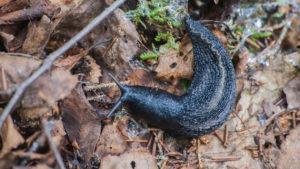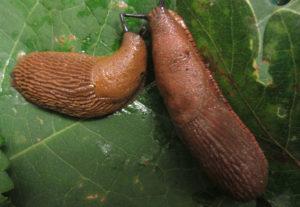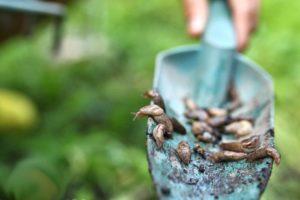How to deal with slugs in the garden: 10 easy ways
In the garden or garden, you just won’t meet anyone. There are all kinds of caterpillars and bugs, butterflies and bees flutter. And there are unpleasant slimy long bodies - slugs. For all their defenseless form, they are malicious pests.
Content
What do slugs look like: photo
Description of slugs
Name: Slug
Latin: Arion lusitacusClass: Gastropoda - Gastropoda
 | Habitats: | anywhere with high humidity |
 | Dangerous for: | greens, vegetables, berries |
 | Means of destruction: | special preparations |
Slugs or slugs are a range of gastropods. But they, unlike the snails familiar to many, have no or modified shell.
The body is long, elongated, bilaterally symmetrical. Due to muscle contractions, they can change their shape. Consists of head, leg and visceral mass.
On the head are a pair or two tentacles that receive information and transmit them for processing. Body cells are phytosensitive, with microvilli. Nerves stretch along the entire body, control movement.
There are two types of mucus that are produced by mollusks: liquid and thick. Both species play important roles: they help to hold on and move along vertical surfaces, maintain moisture and protect against predators.
Slug lifestyle
The average life of mollusks is 12-18 years, but depending on the species, the figures can be much higher.
Reproduction
Slugs reproduce sexually, but there are several different variations of this process.
- The connection of the genitals of different individuals, and there may not be a pair, but even 4.
- Apophalation. The male reproductive organs are bitten off and the females envelop them.
- Throwing. Some species use a different method - males throw sperm in the direction of the genitals.
After fertilization, about 30 eggs are laid in the ground or bedding. After a few weeks, they become eggs, and for another month, individuals develop inside.
Food
Most species are unpretentious and eat organic materials. It can be mosses, leaves, mushrooms. They make useful humus from plant residues - this is their benefit. But there are also predators that feed on their own, caterpillars and earthworms.
In agriculture, they cause significant harm:
- cabbage;
- lettuce;
- seedlings;
- peas;
- strawberries;
- tomatoes;
- cucumbers;
- grapes;
- winter.
They carry various diseases and fungal spores.
Natural enemies
Slugs have many enemies, but there are no animals that feed on these particular mollusks. Among those who like to eat slugs are noted:
- hedgehogs;
- moles;
- rodents;
- shrews;
- rooks;
- starlings;
- seagulls;
- chickens;
- ducks;
- toads;
- frogs;
- snakes.
Habitat
The main condition for the existence of slugs is high humidity. But they are found everywhere. The eggs or adults hibernate deep in the ground.
types of slugs
There are a lot of different gastropod molluscs. There are those that are widespread, and there are species that are found in a certain area.



How to deal with slugs
Do not think that outwardly weak slugs are defenseless. In times of massive animal attack on plantations, it can be quite difficult to eradicate them.
Mechanical methods
These are methods that require time and effort, but will help to effectively protect the site without the use of chemicals.
- Manual collection. In the early morning, when the humidity is high, you need to look at the places under the porches, near the buckets, in the rosettes of strawberries and strawberries, under the grape and cabbage leaves.
- Traps. You can lure gastropods with pleasant aromas for them: beer, kefir, citrus fruits, melons, corn. The container is filled with bait and dug into the ground.
Creating a barrier
This method is very simple - it creates obstacles for the penetration of slugs into the area. They do not like harsh smelly substances, copper-based materials, materials that are not comfortable for animals to crawl on.
They are placed around the perimeter of the site, even better in two lanes. The same fence is placed near the trees or within the vineyard.
Suitable for barrier:
- crushed shells;
- sand;
- lime;
- wood ash;
- mustard powder;
- coffee grounds.
Odorous barriers will be:
- rosemary;
- sage;
- parsley;
- laurel;
- marigold;
- garlic.
Folk methods
These are effective remedies that will help get rid of slugs, but will not harm useful animals. The table below lists the effective methods and their application.
| Dusting | For the treatment of crops, mixtures of preparations are used in equal proportions or slaked lime with superphosphate or tobacco dust and wood ash. The irritating mixture is unpleasant for living creatures. |
| Hot pepper solution | To prepare a decoction, you need to grind 100 grams of dry dried pepper and pour a liter of water. Leave for 48 hours, boil and insist for the same amount of time. For spraying, you need 0,5 liters of decoction and the same amount of soap per bucket of water. |
| Potassium salt treatment | For snails and slugs, it is a poison that quickly kills. But it will be necessary to process several times, because because of the mucus, little gets on the body. A bucket of water for spraying needs 1 kg of dry powder. |
| Tinctures | For 5 buckets of water, you need 2 tablespoons of dry powder, leave for an hour and spray. Zelenka can be used according to the same principle - a jar in a bucket. |
| Unpleasant odors | This birch tar or ammonia solution is scattered or poured over the beds. Repeat every week. |
Chemicals
If there are a lot of mollusks, you need to move on to a quick and effective fight. Chemical preparations that cause death will help in this. They are most often granulated or in powder form. The composition contains substances that destroy gastropods, and the smell attracts them.
The drug is scattered in places where slugs accumulate, but so that it does not fall on the paws of pets.
The best on the market are:
- "Slug";
- "Thunderstorm";
- "Ulicid".
Prevention of the appearance of slugs on the site
Gastropods easily adapt to different conditions, spread very quickly and cause unique harm. To prevent the appearance, you need to reduce the humidity and clean the places where they can breed and eat enough.
- Autumn and spring digging, who will help push the slugs out into the cold or bright sun, where they will die.
- Weeding between rows, so that in the thick grass it is not comfortable for the slugs to rest.
- Remove carrion, pieces of branches and any places where they can live comfortably.
- Mulch plantings with hard material, which will prevent slugs from moving around the site.
- Planting taking into account the neighborhood and avoid thickening.
- Carry out drainage in case of approaching groundwater.
Conclusion
Slugs in the area can do a lot of harm. They voraciously spoil a large number of green parts and various vegetables, and also carry various diseases from crop to crop. It is better to start with prevention, then, if necessary, move on to active protection.
Previous
